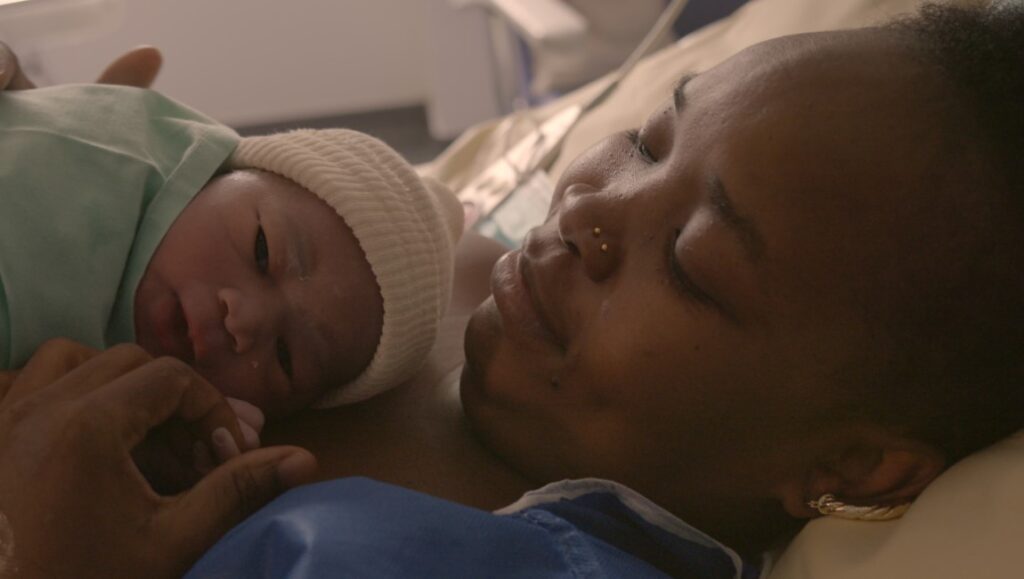Premiering in the Berlinale’s Forum section, Claire Simon’s documentary Our Body follows her 2021 docudrama I Want to Talk About Duras. The title of that previous film, as well as its approach, with its screenplay directly taken from transcripts of the interview it depicts, suggests clarity. However, there’s an opacity inherent both to Yann Andréa as an interviewee and Duras as his subject that renders such clarity impossible. Our Body, filmed in the gynecological wing of a Parisian hospital, quickly charts the opposite trajectory. After a prologue in which Simon explains how the film came about at the suggestion of producer Kristina Larsen after being treated in the hospital for several years, the film’s first patient appears shot only from behind as she speaks to an abortion counselor. Despite the visual obstruction not only of her face, but partially of the counselor’s behind a mask, their conversation is stunning both in its humanity and precision. It’s exceptionally clear that the counselor’s only goal is to attain the best care for her patient, and the patient’s to accurately provide the information necessary in interest of her care.
Eventually, we come to realize this first patient’s face is most likely hidden in order to protect her privacy; she is a teenager, and though she has told both her parents and her partner that she is pregnant and says they support her decision to receive an abortion, she is concerned by their reactions and unsure of her own decision (though that precaution will not again be necessary in the film, and Simon most often situates herself on the side of doctor and patient, panning between their faces, masks, for the most part, remaining in place). This is clearly felt by the doctors, as one who oversees the hormone treatment of trans patients often asks them to briefly remove their masks in order to see and remember what they look like. This desire to connect, to know who they are caring for, defines Our Body. It’s seen perhaps most directly in what may be the gentlest birth scene ever put to film. Barring the two-person camera crew, only the mother and a single doctor are present, as her husband is taking care of their other children, and the cliché chaos of birth is almost entirely eschewed. The scene ends with doctor and patient thanking each other, comparing the experience to having sat down to tea together. The following scene’s C-section may fall closer to the chaotic expectations of birth, but it is still punctuated by clear and compassionate communication.
Being set in a hospital and featuring, though in far lesser quantity and sense, graphic surgery footage, Our Body is sure to recall the recent festival hit from Lucain Castaing-Taylor and Véréna Paravel, De Humani Corporis Fabrica. But though this film’s focus on communication sets it apart from De Humani, it’s also different both from that film and Frederick Wiseman’s similarly marathon institutional documentaries in its lack of strict adherence to observation. Though Simon is generally content to let conversations play out on their own, in quieter moments, she asks patients about their experiences and doctors about their methods. And so, as the film continues, its observational distance increasingly collapses; as a woman prepares to go under for surgery, she thanks Simon by name for filming the process so that other people will know what to expect. Most startlingly, in the film’s final hour, Simon becomes a patient, allowing herself to exhibit the same level of vulnerability as her film’s other subjects.
In one of the film’s few jaunts outside the hospital, Simon films a protest staged by women who were sexually assaulted by doctors. Though this protest appears to be in opposition to the scenes of tremendous compassion that precede and follow it, the conclusion cannot be that it negates the experiences of the women speaking. One possibility is that the observation of the camera precludes such violations. Though this may be too simplistic a read — even if Simon had captured such a traumatic moment, it’s almost unimaginable that she would have included it in the film — as well as an inimitable antidote, it does add to both the film’s emotional and practical heft. Besides functioning as an encouraging artifact for future patients, which is to say nearly everyone, as the woman who thanks Simon for filming her surgery hopes, it may at least be able to serve as a more holistic model for a right relationship between doctor and patient.
DIRECTOR: Claire Simon; CAST: —; DISTRIBUTOR: The Cinema Guild; IN THEATERS: August 4; RUNTIME: 2 hr. 48 min.
Originally published as part of InRO Weekly — Volume 1, Issue 8.5.


Comments are closed.